Run and efficiently scale on various Intel CPUs
Significantly reduce development time

Video analytics powered by AI is revolutionizing industries by extracting insights from visual data streams. Using deep learning algorithms, video content is automatically analyzed and interpreted to detect objects, people, and events. AI video analytics applications are rapidly expanding across sectors, offering benefits such as enhanced security capabilities, improved
operational efficiency, and data-driven decision-making.
Irisity is a leading provider of AI-powered video analytics software serving a wide range of use cases including critical infrastructure security monitoring, fire and smoke detection, slip and fall identification, and traffic monitoring. Its solutions are powered by advanced algorithms that recognize activities and incidents, collect operational intelligence, and generate business insights for better decision-making and optimal operation.
Irisity was looking to improve their offering by further increasing the throughput of their object detection model while maintaining its high accuracy. Doing so would enable Irisity to scale its solutions even more cost-effectively on existing CPU infrastructure, thus reducing operational costs for their customers.
In addition, faster models also deliver better user experience with real time insights and alerts. The ability to generate insights within seconds is key, especially for video analytics applications that address use cases such as security of critical infrastructure personnel, health-care and other time sensitive use cases.
Leveraging Deci’s platform, Irisity’s team developed an enhanced object detection model that outperformed its predecessor in terms of inference performance, all while retaining the original model’s accuracy. The new model, generated with Deci’s Automated Neural Architecture Search (AutoNAC) engine, showcased an impressive throughput increase, moving from 499 frames per second to 3,240 – a 6.5x improvement. The team utilized Deci’s SuperGradients training library to train this new model and further optimized it using Infery, Deci’s SDK for inference optimization and deployment.
The optimized model enabled Irisity to scale their solution by extending its support for a wide range of CPUs. With the help of the Deci platform, the Irisity team not only shortened their development process and minimized associated risks, but also effortlessly achieved their desired performance benchmarks while keeping stringent data privacy in check.
Run and efficiently scale on various Intel CPUs
Significantly reduce
development time

Improve latency and throughput, and reduce model size by up to 5X while maintaining the model’s accuracy.
Maximize hardware utilization and cost-efficiently scale your solution at the edge.
Simplify development with automated tools that guarantee success.

Choose an ultra performant model or generate a custom one.
AutoNAC
Neural Architecture Search Engine
DataGradients™
Dataset Analyzer



Use Deci’s library & custom recipe to train on-prem.
SuperGradients™
PyTorch Training Library



Apply acceleration techniques. Run self-hosted inference anywhere.
Infery
Optimization & Inference Engine SDK
Tell us about your use case, needs, goals, and the obstacles in your way. We’ll show you how you can use the Deci platform to overcome them.


Deci is ISO 27001
Certified
from transformers import AutoFeatureExtractor, AutoModelForImageClassification
extractor = AutoFeatureExtractor.from_pretrained("microsoft/resnet-50")
model = AutoModelForImageClassification.from_pretrained("microsoft/resnet-50")